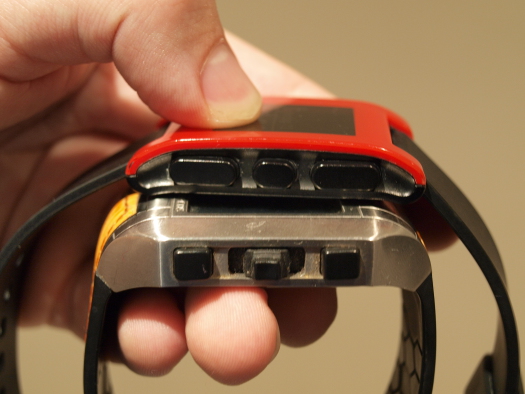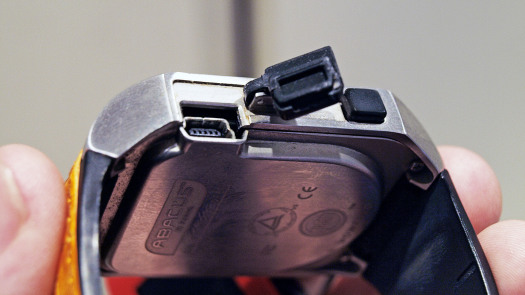
Like any other manufacturer, Apple likes to copy from others – as far as nothing new. What you probably didn't know yet: The forefather of the Apple Watch first saw the light of day in 1999. Back then, the watch manufacturer Fossil contacted Palm about a license for the in-house operating system.
Donald Brewer's team did a great job. The prototype called FX2001 impressed analysts at Comdex 2001 – unfortunately it was too big and too heavy for practical use. Over the next four years, the specs were improved several times: the end result was the m500, which had shrunk to the size of a fat watch.
In contrast to I'm Watch, the WristPDA screen was always active. In addition, Fossil implemented one of the first “dual-core PDAs”: The SuperVZ main processor was able to forward the current screen content to a microcontroller if desired. The latter then took over the update of the 160 × 160 pixel high resolution LCD.

Fossil solved the permanent clock display on an LCD display with a dedicated microcontroller.
What you will learn
Data in step
From a software perspective, the WristPDA was a full-fledged organizer with Palm OS. Data could be synchronized with Outlook via HotSync: appointments, calendar data, ToDos and apps automatically migrated to the handheld. The 8 MB RAM seems to be completely undersized today, but was gigantic at the time.

Thanks to HotSync, data did not have to be entered manually.
The WristPDA could run any PalmOS application. In practice, however, this turned out to be not particularly satisfactory: due to the small number of users, developers were not really ready to equip their programs with user interfaces that were adapted to the clock. As a result, the navigation rocker on the side of the device was used only little.

The WristPDA is far superior to the pebble when it comes to input functions.
Fossil countered this problem by integrating a pen. The buckle of the bracelet contained a fold-out "toothpick" that allowed elements to be tapped.

WristPDA: crutch or awesome?
Too little, too short
Palm has struggled with quality issues throughout its history. The "Curse of the P" continued seamlessly at Fossil: Many of the watches were delivered with batteries that only reached their nominal capacity after good persuasion. Why the decision was made to use the 66 MHz version of the SuperVZ processor remains unclear: the doubling of the output was irrelevant, the reduction in battery life was noticeable.
In everyday life, the watch wasn't just annoying with permanent battery status warnings. It was also not waterproof, which caused trouble when showering or even washing hands. In addition, the loudspeaker was too weak to reliably wake the user up.
Due to sluggish sales, Fossil lowered the price of the product several times. In the end, the remainder of the watch, which was once almost $ 300, was sold for $ 49: As with the last WebOS smartphones, there was rapid sales.
What happened if?
Since Fossil has not been building smartwatches for more than ten years, we want to take a look into the glass ball. As a former PalmSource employee, Mike Mace was very well informed about the developments of the licensees: He reported in 2005 in a blog post that Fossil has discontinued a number of great products.
Let us imagine a WristPDA that would be able to synchronize its data wirelessly thanks to a Bluetooth module: thanks to the radio connection, the product would always be up-to-date even without a workstation. The constantly expanding adaptation would encourage developers to offer optimized applications, the operating concept with the five-way rocker would have worked.
Both the weak speaker and the lack of water resistance could have been remedied as part of a product update. A dock would have solved the charging problem: the next generation of the watch would have been far more acceptable.

Fossil hid the micro USB port behind a (hard to open) flap.
The technology would have developed rapidly during the delivery of this second model. The work on the third iteration would have been under a different star: organic LCDs would have reduced power consumption, while dedicated flash memory (keyword NVFS) would have extended the battery life by making the memory maintenance reserve required for RAM available.
Conclusion
Those who head for the moon with their spaceship sometimes land in the stars – or in a black hole. This was exactly what happened to the Fossil team: the first generation of the WristPDA was on the right track, but due to the technology at the time, it could not develop fully. The discontinuation of the successors described by insiders as great was an act of unprecedented short-sightedness – fossil today would be a serious force in the smartwatch field.
You can find more impressions of the smartwatch from the last millennium in the following picture gallery.

Fossils WristPDA looks futuristic – even today. The battery of our copy is defective, which is why we take it "on a short leash"
Do you have further questions about WristPDA? I'm personally looking forward to getting you answers – just leave me a comment.
Permalink: https://bwellmart.com/-2442029
Tags
AB SMART HEALTH REVIEW







![[CES] Diesel announces the On Fadelite, a transparent smart health connected watch](https://www.bwellmart.com/wp-content/uploads/2020/01/montre-connectée-Diesel-On-Fadelite-1-660x330.jpg)
